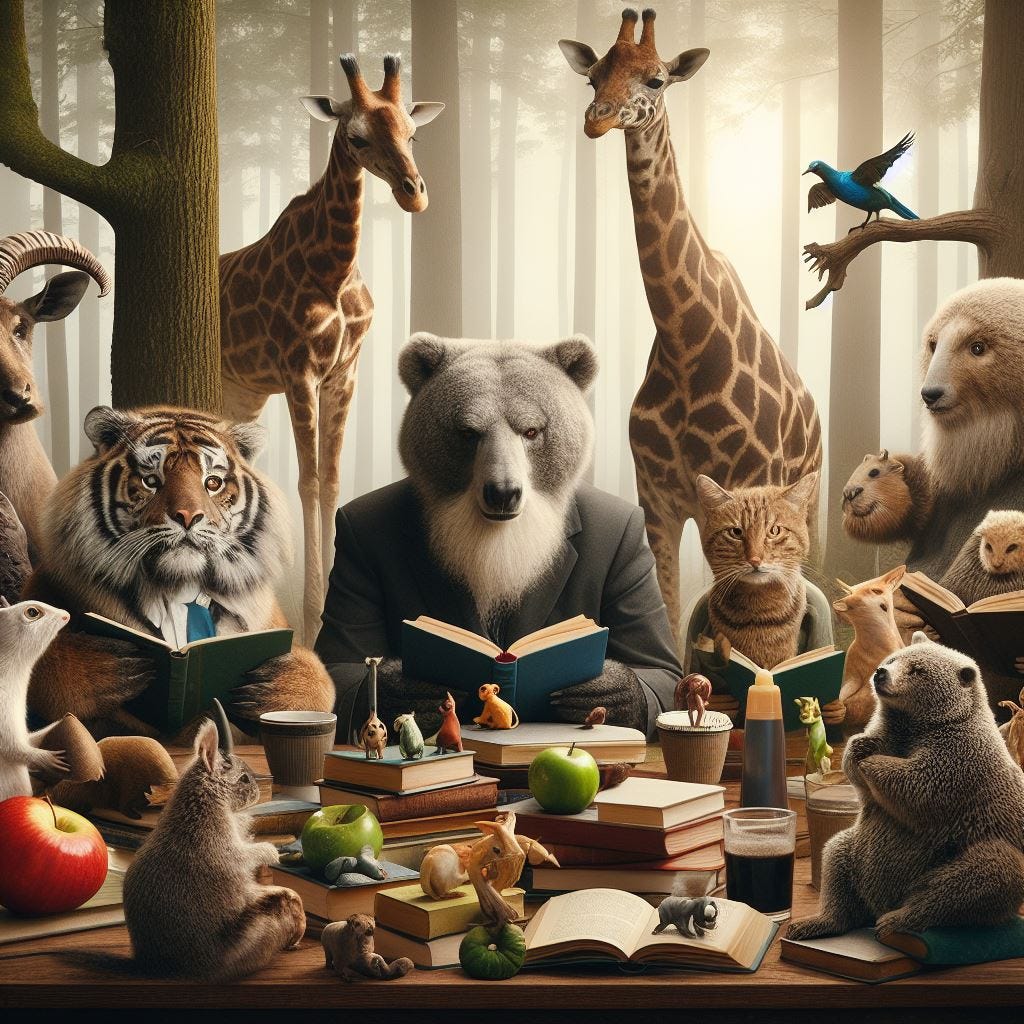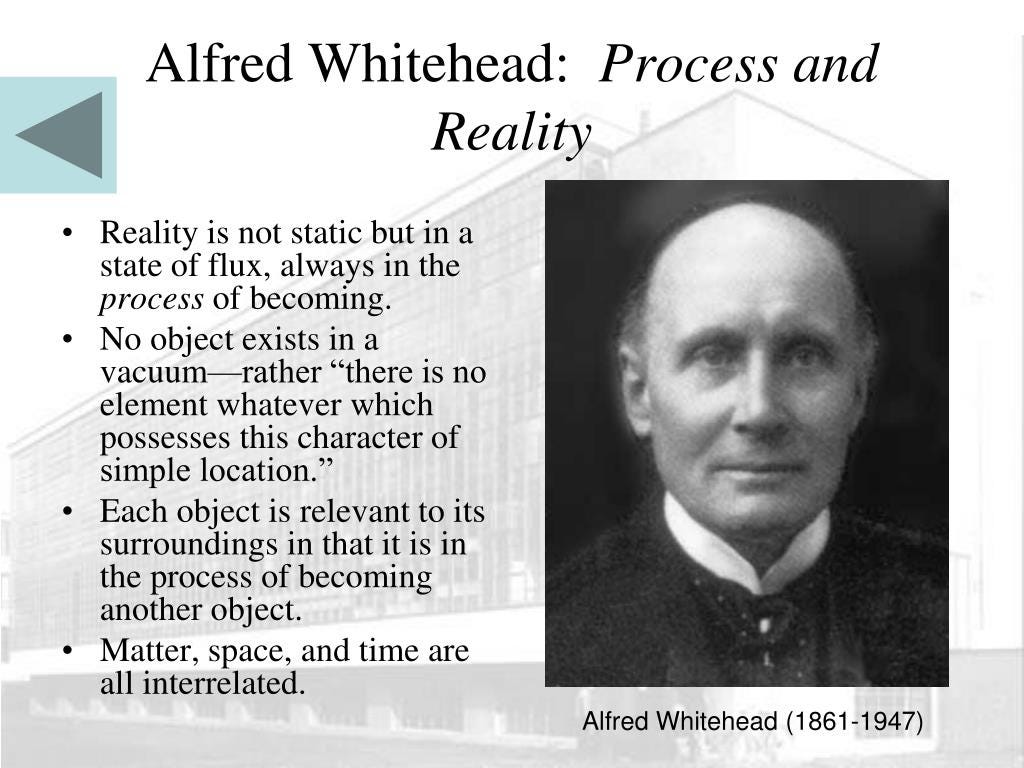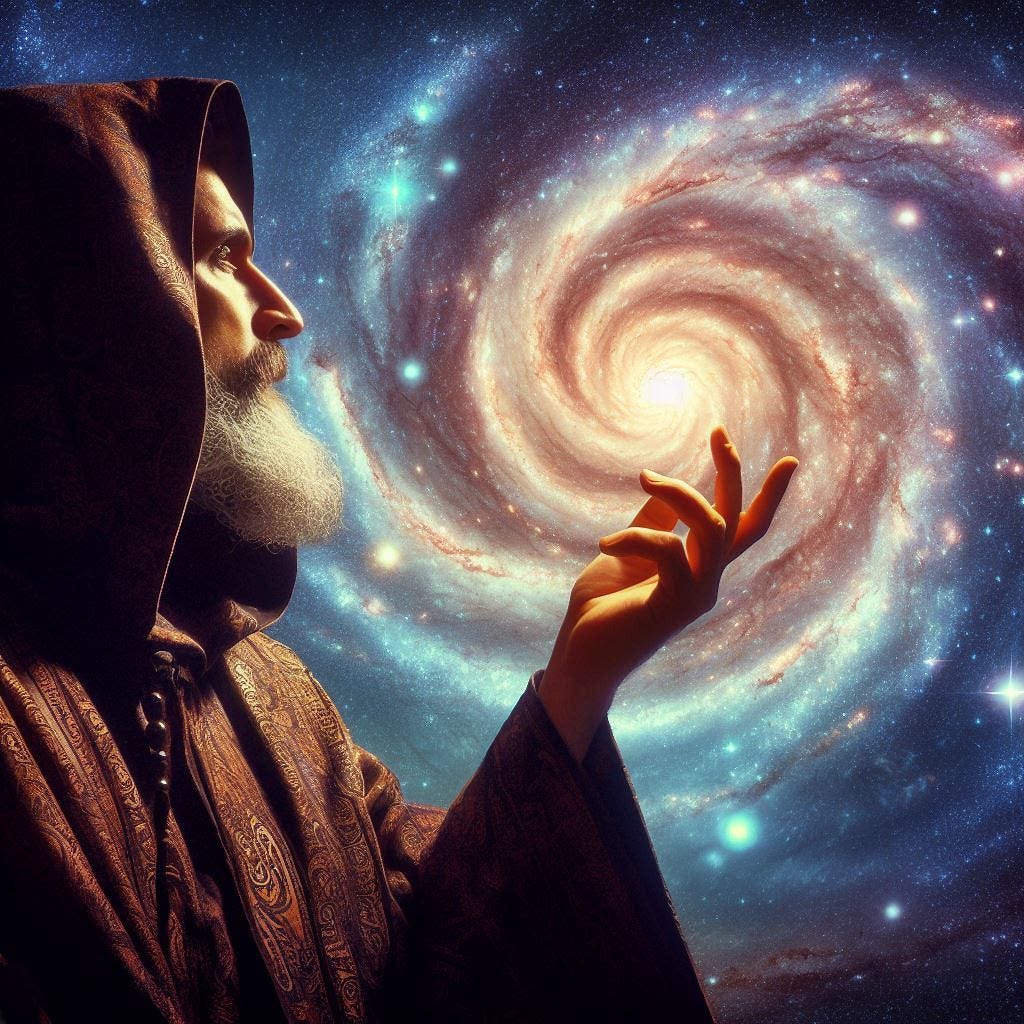Our Conscious Universe
Sojourning Beyond Materialism
“It is natural to think that an abstract science cannot be of much importance in affairs of human life, because it has omitted from its consideration everything of real interest.”
— Alfred North Whitehead
In the wake of recent discussions on animal consciousness, as highlighted by the Nature article of April 19, 2024 — “Do insects have an inner life?” — a profound question resurfaces, challenging the very foundations of modern scientific thought: Is the universe conscious?
This inquiry, far from being new, echoes through the annals of history, from the ancient philosophers who held pantheistic concepts such as Plato and Aristotle, through the mechanical animal concepts of Giovanni Borelli in the Renaissance, to the panpsychic universe proposed by Alfred North Whitehead, and into contemporary musings on plant intelligence and conscious stars. It entices us to reconsider not just the nature of consciousness but the very fabric of reality itself.
The Mechanical Universe
The 17th-century natural philosopher Giovanni Borelli, along with his contemporaries, laid the groundwork for a mechanistic view of life. By dissecting animal motion through the lens of mathematics and gravity, Borelli signally contributed to a worldview that sees living beings as mere automata—Contra Spiritus. This mechanical universe, devoid of consciousness except in humans—though we have to wonder about scientists—has dominated scientific thought, leading to a reluctance to acknowledge the obvious: animals, displaying complex behaviors, nurturing their young, avoiding pain or to be eaten, exhibit a fundamental awareness, indicating functional intelligences of diverse levels.
Yet, this bio-mechanical perspective, then fitting the advent of materialism in the sciences, now can be seen as a reduction too far, skewing science for centuries. The complexity of animal behavior, their emotions, and social structures hint at a depth of consciousness that mere mechanics cannot explain. The observer who denies this is, indeed, lacking in proper intellectual and natural scientific scope.
Whispering Trees and Neural Fungi
Moving from fauna to flora, the notion of plant consciousness invites us to expand our comprehension of intelligence. A growing number of breakthrough researchers like Paco Calvo—Planta Sapiens, Peter Wohlleben—Hidden Life of Trees, Suzanne Simard—Intelligent Trees, Stephen Harrod Buhner—Plant Intelligence, and Prof. Stefano Mancuso—Roots of Plant Intelligence have peeled back the layers of plant behaviors and responses, revealing a world teeming with communication, learning, and memory.
Trees that whisper secrets through the Wood Wide Web, fungi acting as neural and transport networks that orchestrate the flow of information and nutrients throughout the forest floor, first to trees’ offspring, then to related species, suggest a form of intelligence that openly defies the traditional, neuron-centric view of individuated animal intelligence. These organisms exhibit astonishing awareness and sensitivity to their environment, indicating a level of consciousness that challenges convention.
This complexity, along with the further symbiotic relationships plants maintain with insects, animals, and microbes, points to a panpsychic intelligence woven into the very fabric of Nature. We inhabit a universe where consciousness is not a chance anomaly but rather is a fundamental aspect, and, no doubt, by logic, the progenitor of material existence.
Stars That Dream and the Philosophy of Everything
“The foundation of reverence is this perception, that the present holds within itself the complete sum of existence, backwards and forwards, that whole amplitude of time, which is eternity.” — Alfred North Whitehead
Alfred North Whitehead’s philosophy offers a conceptual framework for understanding this panpsychic universe. By positing that reality is composed of “occasions of experience,” Whitehead invites us to view consciousness as a spectrum, present in varying degrees across all entities.
This view is further expanded by Greg Matloff’s audacious thesis of conscious stars, suggesting that even celestial bodies may possess a form of awareness.
Can Panpsychism Become an Observational Science?
Gregory L. Matloff
Physics Dept., New York City College of Technology, CUNY, Brooklyn, NY, USAAbstract
In 2011, I was invited to participate in a symposium at the London headquarters of the British Interplanetary Society. The subject of the symposium was the contributions of philosopher/science-fiction-author Olaf Stapledon. Instead of concentrating on the many technological projections in Stapledon’s masterwork Star Maker, I elected to investigate whether there is any evidence to support his core metaphysics—that the universe is in some sense conscious and that a portion of stellar motion is volitional (as an alternative to Dark Matter). Stars do not possess neurons or tubules, but the spectral signatures of cooler stars such as the Sun reveal the presence of simple molecules. A universal proto-consciousness field congruent with vacuum fluctuations could interact with molecular matter via the contribution of the Casimir Effect to molecular bonds. Surprisingly, there is observational evidence that cooler stars move somewhat faster around the galactic center than their hotter sisters. This velocity difference, called Parenago’s Discontinuity, occurs in the stellar temperature distribution where molecular spectral lines become apparent. Data from Allen’s Astrophysical Quantities and the European Hipparcos space observatory reveal that Parenago’s Discontinuity is found in main sequence stars as far as ~260 light years from the Sun and in giant stars at distances greater than 1,000 light years. As discussed in the paper, local explanations for Parenago’s Discontinuity seem inadequate. Gaia, a successor to Hipparcos, is currently on station observing positions and motions of ~1 billion stars in our galaxy. If the Discontinuity is a galaxy-wide phenomenon, the volitional star hypothesis will be advanced. One way that a minded star could alter its galactic trajectory is by the emission of a uni-directional jet. Such jets have been observed in young stars. Future work will hopefully show how uni-directional jets correlate with star temperature and distance from the galactic center. It is therefore not impossible that panpsychism can emerge from philosophy to become a subdivision of observational astrophysics.
This radical reimagining of the cosmos, where consciousness permeates every level of reality, from geology, through the diversity of life in the biosphere, all the way to the astrophysal realm (which requires a major revamp from the dogmatic imaginative math-based nonsense of the present view — I should evoke Halton Arp … another day!), demands a new paradigm in scientific research. It insists on an approach that recognizes the intrinsic value and intelligence of all life forms and potentially matter itself, one in which the observer acknowledges themselves as integral to the observed processes.
The Goethean Path to Awareness
The key to unlocking this new paradigm is domiciled in the Goethean scientific approach. By engaging with the world through direct, empathetic observation, Goethean science encourages a wholistic comprehension of Nature. It is an approach that transcends the materialist-reductionist viewpoint, favoring a universe alive with meaning and intentionality.
In this light, the universe is not a cold, indifferent machine but a vibrant, conscious entity, an irreducible wholeness. Matter arises from consciousness, not the other way around. This panpsychic perspective enobles our comprehension of the cosmos, fostering a deeper connection with the world around us.
Goethe’s Scientific Approach
“There may be a difference between seeing and seeing, that the eyes of the spirit have to work in perpetual living connection with those of the body, for one otherwise risks seeing and yet seeing past a thing.” — Goethe Johann Wolfgang von Goethe was one of the foremost intellectuals of the 18th and 19th centuries. Known as a si…
Awakening to the Universe
As we stand at the Borderlands of science and philosophy, it’s time to do the unthinkable — think beyond the thralldom of materialism, into the living spirit of manifestation. The universe, with its conscious stars, thinking forests, and sensible animals, invites us to expand our minds to greater ideas and higher knowledge. It is an open challenge to the materialist-reductionist dogma, a call to consciously experience and embrace a universe brimming with consciousness.
In this conscious universe, every leaf, star, and creature has a story, as living sparks of the blossoming universal mind. By listening to these stories, we not only uncover great mysteries of consciousness but also rediscover our place in the cosmos. It’s a journey of transformation, from seeing the world as a collection of inert objects to experiencing it as a communion of conscious subjects.
Welcome to our conscious universe, where the adventure of awakening beckons.
Thank you for reading!
Your continued support means the world universe to me.
Your contributions help me create and share more content like this, allowing me to spend more time on research and invest in better equipment.
If you enjoyed this article, please consider becoming a paid subscriber or making a one-time donation to support my work.
You can contribute through:
Sharing this content with your friends and family.
Any amount, big or small, is greatly appreciated. Thank you for your generosity!










